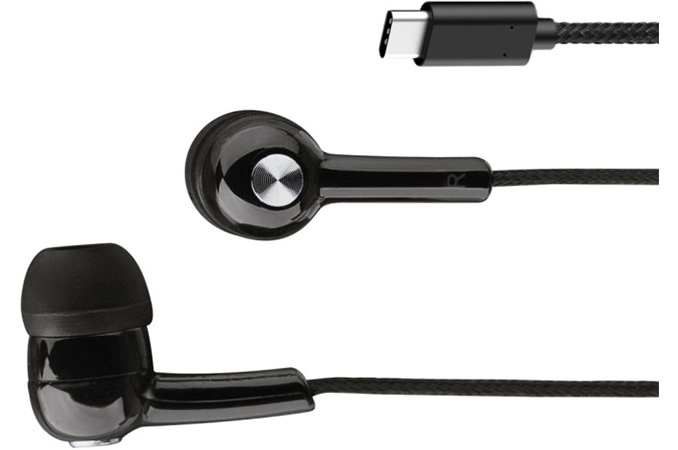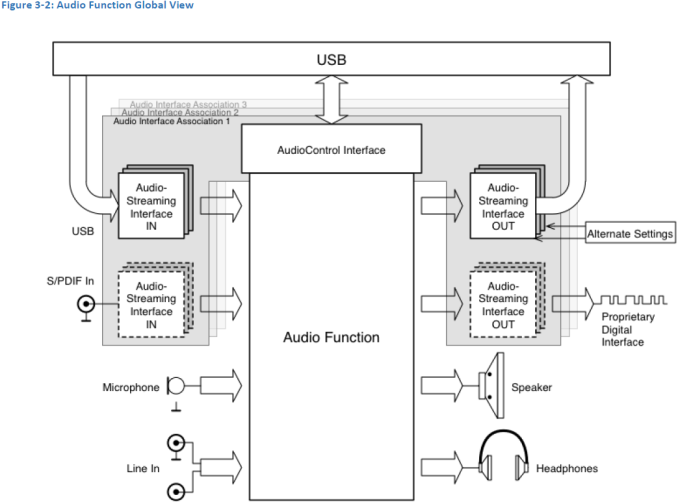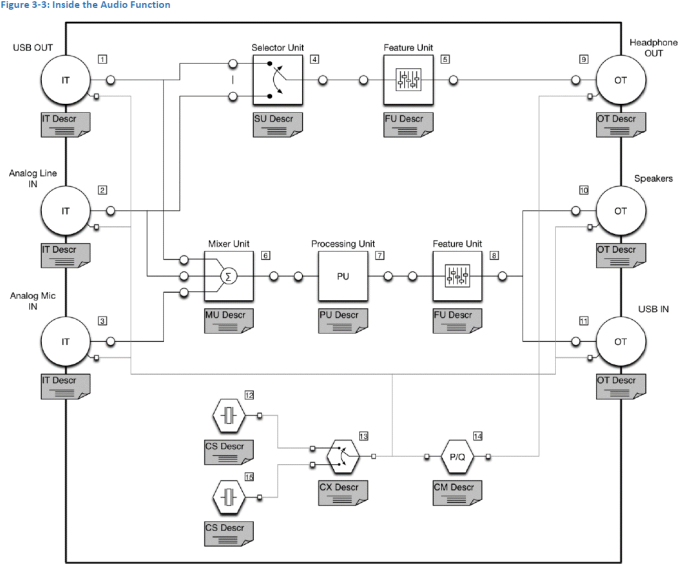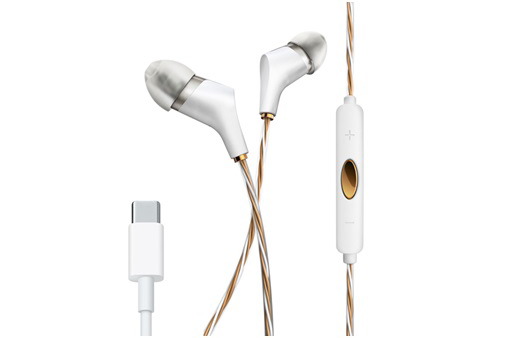USB-IF Publishes Audio over USB Type-C Specifications
by Anton Shilov on September 30, 2016 12:00 PM EST- Posted in
- Mobile
- USB-C
- USB-C Digital Audio

The USB Implementers Forum this week published the USB Audio Device Class 3.0 specification, which standardizes audio over USB Type-C interface. The new spec enables hardware makers to eliminate traditional 3.5mm mini-jacks from their devices and use USB-C ports to connect headsets and other audio equipment. Makers of peripherals can also build their audio solutions, which use USB-C instead of traditional analog connectors. Developers of the standard hope that elimination of mini-jacks will help to make devices slimmer, smarter and less power hungry.
The industry, led by Intel and some other companies, has been mulling about replacing the traditional 3.5mm mini-jack connector for some time now. The main motives for replacement were necessity to simplify internal architecture of devices by removing analog and some audio processing components from the inside (which leads to further miniaturization), minimize the number of external connectors, improve power management as well as to add smart features to headsets and other audio equipment. We discussed USB Type-C Audio Technology briefly earlier this year and mentioned that this is not the first time that the industry has tried to use USB instead of the good-old mini-jack. The important difference between contemporary initiative and attempts in the past is the fact that today the primary goal is to replace the 3.5mm jack in portable devices.
As reported, the USB Audio Device Class 3.0 specification supports both analog and digital audio. Analog audio is easy to implement and it does not impact data transfers and other functionality of USB-C cables since it uses the two secondary bus (SBU) pins. Some device makers may find the analog audio feature of the standard to be a relatively simple way to add certain smart capabilities to their headsets without major redesign of hosts. While analog USB-C audio will not help to shrink dimensions of portables, it could be particularly useful for non-mobile devices, where miniaturization is not crucial, but where port space is at a premium or where additional features either make sense (infotainment, sport equipment, etc.) or are fundamental (VR HMDs).
The USB ADC 3.0 defines minimum interoperability across analog and digital devices in order to avoid confusion of end-users because of incompatibility. In fact, all ADC 3.0-compliant hosts should support the so-called headset adapter devices, which allow to connect analog headsets to USB-C. However, digital audio is one of the primary reasons why companies like Intel wanted to develop the USB-C audio tech in the first place, hence, expect them to promote it.
According to the USB ADC 3.0 standard, digital USB-C headphones will feature special multi-function processing units (MPUs), which will, to a large degree, define the feature set and quality of headsets. The MPUs will handle host and sink synchronization (this is a key challenge for digital USB audio), digital-to-analog conversion, low-latency active noise cancellation, acoustic echo canceling, equalization, microphone automatic gain control, volume control and others. Such chips will also contain programmable amplifiers and pre-amplifiers, which are currently located inside devices. Besides, USB ADC 3.0-compatible MPUs will also support USB Audio Type-III and Type-IV formats (the latest compressed formats), but will retain compatibility with formats supported by ADC 1.0 and 2.0. Finally, among the mandated things set to be supported by USB-C Audio devices are new Power Domains (allows devices to put certain domains in sleep mode when not in use) as well as BADD (basic audio device definition) 3.0 features for saving power and simplified discovery and management of various audio equipment (each type of devices has its own BADD profile).
Over the past few months, Conexant has introduced three USB-C Audio MPUs (1, 2) for headsets, docking stations and other equipment. Assuming that these chips are compliant with the USB ADC 3.0 specs from a hardware standpoint, and the software is ready, actual devices featuring USB-C Audio could arrive in the coming months. Pricing of the first USB ADC 3.0-compliant MPUs is unknown, but in general MPU ICs do not cost too much. Moreover, as developers adopt smaller process technologies and a larger number of such chips hit the market, their prices are going to decline. In the end, it will be interesting to see where digital headphone prices end up. The MPUs will definitely add to the total bill of materials for a set of headphones, but at the same time they add new functionality as well, so the big question is how manufacturers then factor all of that into device pricing.
A number of companies, including Apple and LeEco, have already introduced smartphones that do not use traditional mini-jacks, and Google added support for USB DAC devices to Android over a year ago. The finalization of the USB ADC 3.0 spec, introduction of USB-C audio ICs, as well as design decisions of smartphone makers demonstrate that the industry is trying to eliminate 3.5mm jacks from mobile devices. The big question is whether the rest of the industry plans to do the same. It is true that portables are primary devices for music listening for many people. However, there are tens of applications which still rely on analog connectors, and hundreds of millions of people who use them either to consume or create content. To eradicate 3.5mm jacks completely, USB-C Audio promoters will have to work with thousands of vendors and this takes time. Consequently, it is too early to say that this is the end for the good-old mini-jack.
Images by Conexant, USB IF.
Source: USB IF













93 Comments
View All Comments
yankeeDDL - Monday, October 3, 2016 - link
Totally. Creating problems where they don't exist. Instead of focusing on making ergonomic phones, with reasonable thickness and grip, using this space to house a large battery that can give me 2~3 days of use, they go thinner, and take out the jack.So on 10hrs flights what do I do? I use my headset with the adapter, and charge the phone every now and then? Or I buy wireless headsets and use then only 4~5 hours? Or I buy a new adapter to plug in both? I really don't understand how people can actually buy phones without a 3.5mm jack.
Shiitaki - Sunday, October 9, 2016 - link
Everyone is making a big deal out of headphone jack, the reality is the big news should be about the W1 chip! Apple did it again to the technology sector, solving a f'n obvious and glaring failure of the industry.I am looking forward to buy a set of headphone that with a single pairing will work across all of my devices, offer a completely digital connection to a high quality DAC in the headphones themselves. The remote control will be better than the current analog scheme.
Yes, they got rid of a useful jack, but they did it at the same time they addressed the biggest reason that headphone jack still exists!
What is the response of the too slow, and too late industry? Analog audio over a digital connection? Seriously? There are issues with USB, and audio is not one of them. How about the consistently substandard bandwidth of USB devices? The waste of cpu utilization of using usb devices? The lack of Microsoft to implement standard usb profiles, unlike unix.linux, and os x?
The large market for usb is largely cheapskates, and they don't care about audio. This whole thing is a waste of time. In a couple of years people will view headphones with cords like they view boob tube televisions. The move to wireless audio is going to happen fast, very fast.
Android phones have wireless charging, we expect wireless internet connectivity, wireless video transmission. Of all of the connections to go wireless, the audio is the easiest since it is the lowest bandwidth by far.
Apple makes up 90 percent of market by profit, and what is profitable happens. So big deal, you have to buy a new aux cable for your old car stereo for 10 bucks of Amazon, get over it. Wish I had a manufacturing plant in China making cables, there is a tremendous opportunity for making replacement headphone cables for high end corded headphones right now.
Wired? No one cares! These engineers should stop wasting time solving no one's problem. Go do something about PC bluetooth's problems.
Old_Fogie_Late_Bloomer - Friday, September 30, 2016 - link
Oh goodie, another way for manufacturers to shave off a few cents and fractions of a millimeter. If only there was some way to capitalize on slightly thicker devices, like, I don't know, bigger batteries?Scabies - Friday, September 30, 2016 - link
No, you will take your tiny battery and monster screen and you will like it.rms141 - Friday, September 30, 2016 - link
Congratulations, the thinner phone means your battery case will now take less room in your pocket.Flunk - Sunday, October 2, 2016 - link
There are a couple of devices like that on the market like the Moto X Play/Droid Maxx 2. I know because I looked for one when I bought my last phone.Zak - Friday, September 30, 2016 - link
Yeah, no kidding. There was no technical reason to remove the headphone jack. And I bet this standard will not come with iPhones. Apple will have their own "standard". You know, "for the customer benefit".gsilver - Friday, September 30, 2016 - link
I believe that the word that you are looking for is "courage"baka_toroi - Friday, September 30, 2016 - link
Well, Apple devices use a different connector than USB Type-C, so of course this won't come with iPhones.cygnus1 - Friday, September 30, 2016 - link
The Apple Lightning connector has had similar capability for several years. The only difference to my knowledge, is that it doesn't support analog output.